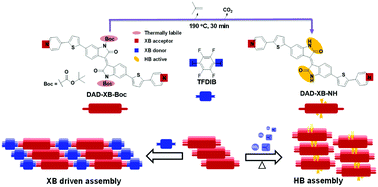
Presented are design strategies towards hierarchically assembling a C2-symmetric π-conjugated oligomer (DAD-XB-Boc) based on a donor–acceptor–donor motif through hydrogen bonding (HB), halogen bonding (XB), and π-stacking interactions. Upon co-crystallization with tetrafluoro-1,4-diiodobenzene (TFDIB), single crystal X-ray analysis reveals highly directional XB induced 2D assemblies which further organize via π–π interactions. Crystal photoluminescence (PL) analysis indicates that the co-crystal exhibits a red shift in its PL spectrum with enhanced intensity compared to the mono-crystal. Pyrolytic cleavage and removal of the t-butyloxycarbonyl (Boc) groups of DAD-XB-Boc exposes complementary hydrogen bonding sites; the H-bonding capability of DAD-XB-NH is evident from thermal gravimetric analysis (TGA) and infrared (IR) spectroscopy. Overall, the data show that both halogen and hydrogen bonding can be used together with π-stacking interactions to enhance the solid-state properties of DAD oligomers essential for optoelectronic device applications. Ongoing work seeks to use such supramolecular approaches to control the nanoscale to microscale arrangement of molecules in thin films and increase device efficiency (i.e., charge mobility).
